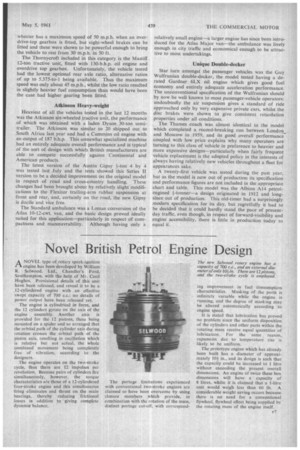Novel British Petrol Engine Design
Page 95

If you've noticed an error in this article please click here to report it so we can fix it.
ANOVEL type of rotary spark-ignition engine has been developed by William R. Selwood, Ltd., Chandler's Ford, Southampton, with the help of Mr. Cecil Hughes. Provisional details of this unit have been released, and reveal it to be a .12-cylindered engine with an effective swept capacity of 700 c.c.: no details of power output have been released yet.
The engine is cylindrical in form, and the 12 cylinders gyrate on the axis of the engine assembly. Another axis is provided for the 12 pistons, these being mounted on a spider and so arranged that the orbital path of the cylinder axis during rotation crosses the orbital path of the piston axis, resulting in oscillation which is relative but not actual, the whole combined movement being completely free of vibration, according to the designers.
The engine operates on the two-stroke cycle, thus there are 12 impulses per revolution. Because pairs of cylinders fire simultaneously, however, the torque characteristics are those of a 12-cylindered four-stroke engine and this simultaneous firing eliminates end thrust on the main bearings, thereby reducing frictional losses in addition to giving complete dynamic balance.
The portage limitations experienced with conventional two-stroke engines are claimed to have been overcome by using closure members ,which provide, in combination with the rotation of the mass, distinct portage cut-off, with correspond ing improvement in fuel consumption characteristics. Masking of the ports is infinitely variable while the engine is running, and the degree of masking may be altered automatically according to engine speed.
It is stated that lubrication has proved no problem since the uniform disposition of the cylinders and other parts within the rotating mass receive equal quantities of lubrication. For the same , reason, expansion due to temperature rise is likely to be uniform.
The prototype engine which has already been built has a diameter of approximately 10+ in., and its design is such that the capacity could be increased to 1 litre without exceeding the present overall dimensions. An engine of twice these box dimensions will have a capacity of 8 litres, whilst it is claimed that a 1-litre unit would weigh less than 60 lb. A considerable weight saving occurs because there is no need for a conventional flywheel, flywheel effect being supplied by the rotating mass of the engine itself.








































































































































































































































































